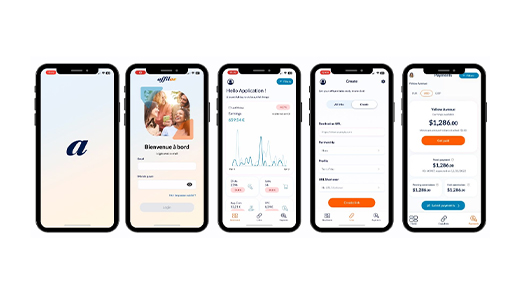Which affiliates should you recruit and why?
Once your affiliate program has been created, the issue will be to figure out how to recruit affiliates, and first how to recruit them, but mostly who: what type of affiliates should you reach out to? What benefits? What type of compensation?
Here are some tips and tricks on how to leverage growth within your affiliate program.
Content affiliates
These are media, blogs, communities and any other content-rich website. These are the most qualitative affiliates in terms of editorial content and visibility offered to your brand. They work your conversion tunnels upstream and act as prescribers since they showcase your products.
- Benefits: The benefit is that even if these sites traffic volume is sometimes lighter (blogs), they can actually bring you a highly targeted audience of internet users, often vertical, and who may become potential customers.
- Types of compensation: All types of commissioning are possible (CPS, CPL, CPC, CPM, CPV, fixed fees… or, last but not least, product offers).
- Note: Not all publishers in this group are professionals and they do not understand fully the issues related to online advertising. Assistance with the setup and regular follow up is needed in order to build lasting and rewarding partnerships.
Maintaining a number of content websites within your campaign is the best way to be active with your core target and work 3 main axes for your brand: notoriety, SEO and sales.
Social Media: influencers
These are social networking pages with massive fans and followers base, complete with an advanced targeting accuracy (exploitation of demographic and geographic data from user accounts). Why not use these new growth channels based on your segmentation criteria with much more exploitable accuracy and network effects, such as Instagram, Facebook or even Youtube.
- Benefits: Active communities, accurate segmentation, brand awareness strategy, discovery.
- Ways to compensate: All types of commissioning are possible (CPS, CPL, CPC, CPM, CPV, fixed fees… or, last but not least, product review).
- Note: Social media campaigns are very relevant and can generate qualified and conversion traffic, but be careful to select proper partners upstream. For example, you can rely on their audience, how viral they are, the number of comments, etc.
Shopping engines & Shopping guides
Comparison tools and Shopping Guides help users find the best product quickly, at the best price or fitting your tastes and colors. There are price comparison tools and those that focus on a product sector or category. Customers browse the publisher’s catalog and are redirected to the merchant’s website.
- Benefits: Increase traffic and visibility for your products.
- Types of compensation: Essentially CPC, marginally CPS
- Note: This affiliate typology works with product feeds (CSV, XML for example). You will then need to go to a feed manager to optimize the distribution of your catalog and, for example, to select the products you want to highlight.
Retargeting agencies
Retargeting is a powerful tool that allows you to target internet users who have visited your site without making any purchase. In other words, to retarget internet users according to their behavior (visited pages, clicked products, cart abandoned, newsletter, etc.). This channel is even more important when you know that more than 90% of Internet users leave a website without making any purchase.
- How: simple or dynamic retargeting display (product feed usage) – Email remarketing (pick the abandoned carts back up thanks to targeted email reminders)
- Ways to compensate: CPC, CPS
- Notes: 1) Some actors add acceptance criteria for advertisers such as a minimum number of unique visitors/month under which it will not diffuse campaigns unless it’s an exception. 2) Some will ask you to work with a post-view cookie (post-impression), but there is a risk: cannibalize post-click sales). There is, therefore, a genuine interest in your brand or product. This is why it is necessary to oversee the setting up of a post-view cookie: check its tracking period and the type of ads display.
On-site solutions to re-engage the user
The goal of this customer retention technique is to engage users who are about to leave your site. If your conversion rate is historically low or if you want to reduce your bounce rate or convert more leads into customers by playing on sales volumes, you may well need these affiliates.
- Systems: Reminders for abandoned carts, collecting emails, up and cross-selling, leaving a site etc.
- Benefits: Conversion Activation tool, allows you to convert undecided users.
- Type of compensation: CPS, Fix fees
- Note: Beware of these overlays (pop-ups), your navigation scenarios must be planned in advance to allow you to trigger these actions at the right time for your user and not in an unintentional way.
Coupons / Vouchers
Coupon codes are one of the most popular methods of affiliate promotion. The promo code sites offer users to save on their purchases by disseminating the promo codes provided by advertisers. They allow you to influence your conversion rate by implementing a promo code policy (% discount on first order, free shipping etc.).
- Benefits: Conversion activation tool, Internet users looking for opportunities and good deals.
- Type of compensation: CPS (Cost Per Sale)
- Note: Criticized with the last-click attribution logic, today’s merchants seek to streamline costs. To do this, they are increasingly looking at conversion tunnels in order to analyze the contribution of each of its actors (attribution, commission sharing). As a result, some coupon sites are now reinventing themselves towards more qualitative content (content writing, product focus, branding or even newsletter promotion).
The implementation of a promo code policy must, therefore, be part of a real strategy otherwise your sales will be cannibalized and your margin will fall (coupon code + commission). It’s also interesting to wonder what the site offers in terms of visibility, aside from displaying the promo code. Ask yourself how long a promo code lasts, what are its conditions of validity, what is the interest based on your target, what other types of “content” is there for your brand.
Tips: For those who want to go further, one of the possible strategies is to create on your site a page listing your current coupon codes and to reference that page with Google Ads (coupon + “your brand”), it will only cost you a few cents, and you will get the internet users who leave your site to find a promo code: you’ve come full circle!
Cashback
These are sites that offer their users to recover part of the amount of their purchases. Cashback users communities are very active and, for example, some Internet users no longer order without having received their cashback.
Ex: For an order of 100 euros on which you offer a 10% commission, a cash backer pays his/her user 6%, i.e. 6 euros and pays him/herself 4%,i.e.4€.
- Benefits: Conversion activator, active communities, opportunists.
- Ways to compensate: CPS (Cost Per Sale)
- Note: This is also a controversial situation because these are sites that appear at the end of a conversion and which, in a last-click logic, often complete the conversion tunnels. However, this classification has less impact on your margin because you only pay the commission. The affiliate then splits his/her remuneration to share it with his/her user. As in the previous remark, this also calls for a reflection with the affiliate on the proper highlights to use.
Important: Often, cashback sites also highlight the advertiser’s promo codes, so it becomes necessary to check the origin of the conversions in the ‘refer’ in order to verify that the purchase does come from an actual valid promo code or cashback.
For you, it’s all about launching campaigns to acquire potential new customers, new members or subscribers, by using segmented shopping email bases.
- Benefits: An accurate segmentation, you can opt to shoot bases based on your segmentation criteria and therefore your target. Each lead is therefore an up close potential customer, which implies a higher transformation rate.
- Compensation methods: CPL, CPC & more marginally CPS with MG (Minimum Guarantee)
- Notes: Not all email databases are equal and the quality of the leads sometimes puzzling given the high number of frauds. In recent years companies have been building charters as bulwarks against the quality of bases and information, but with what control? Special attention is needed especially if the tracking methods that are being used and that do not protect you natively against fraud.
A piece of advice: Unless you have some expertise in the management of email campaigns, you will probably need some help (creating a landing page, emails, tracking pixels, recruitment of email bases, testing the relevance of the bases on a sample, launching campaigns and analyzing performance).
Keywording / PPC campaigns
These are affiliates that specialize in buying keywords on search engines (Google, bing, Yahoo etc.) and who sell them at the performance on sales that they generate for you with these campaigns.
- Benefits: Delegating your Google Ads campaigns to performance
- Ways to compensate: CPS or CPC
- Note: Give special attention to the validation of the keyword strategy on which they are present in order to not compete with your internal campaigns. For example, you can control the proportion purchase brand name, general keywords.
What should you remember?
- These classifications are all growth drivers for your business.
- However, depending on your field of activity, not all of them will actually be relevant. It’s worth testing, measuring and adjusting your campaigns and focusing on levers that offer a genuine added value for your brand.
- For example, content and social media affiliates are no doubt the toughest to seduce and their management is time-consuming. But it is by far the one that will bring you the most targeted and therefore loyal customers.
- The regular follow up of partnerships will also allow you to optimize your marketing campaigns and to do A/B testing on the comparative performance of your advertising materials (banners, email, etc.). You can also negotiate relevant highlights based on the volumes generated.
- These different types of affiliates can coexist within the same program provided they have attribution logics other than the last click, such as commission sharing. It then becomes relevant to use them together to analyze each other’s contributions within your conversion tunnels.
Share :




